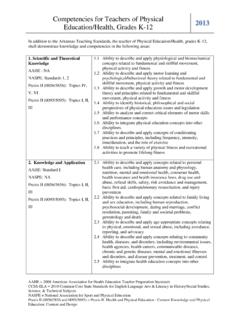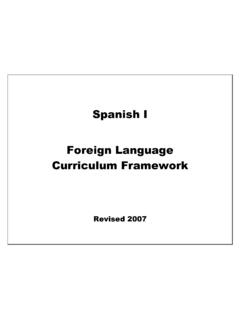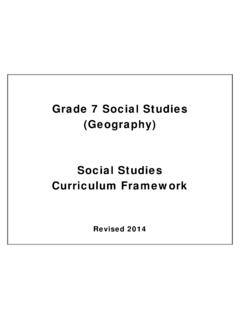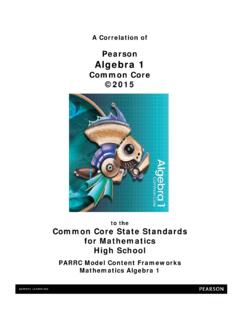Transcription of Algebra III Curriculum Framework - State Board of Education
1 Algebra III Curriculum Framework 2012 1 Algebra III common core State Standards for Mathematics Arkansas Department of Education 2012 Course Title: Algebra III Course/Unit Credit: 1 Course Number: 439070 Teacher Licensure: Please refer to the Course Code Management System ( ) for the most current licensure codes. 9-12 Grades: 9-12 Prerequisite: Algebra I, Geometry, Algebra II Algebra III This course will enhance the higher level thinking skills developed in Algebra II through a more in-depth study of those concepts and exploration of some pre-calculus concepts. Students in Algebra III will be challenged to increase understanding of algebraic, graphical, and numerical methods to analyze, translate and solve polynomial, rational, exponential, and logarithmic functions.
2 Modeling real world situations is an important part of this course. Sequences and series will be used to represent and analyze real world problems and mathematical situations. Algebra III will also include a study of matrices and conics. Arkansas teachers are responsible for integrating appropriate technology and including the eight Standards for Mathematical Practice found in the common core State Standards for Mathematics (CCSS-M). Algebra III does not require Arkansas Department of Education approval. Prerequisites: Algebra I, Geometry, Algebra II Strand Content Standard Matrix Operations 1. Students will perform operations with matrices and use them to solve systems of equations.
3 Conic Sections 2. Students will identify, analyze, and sketch the graphs of the conic sections and relate the equations and graphs. Function Operations and Properties 3. Students will be able to find the inverse of functions and use composition of functions to prove that two functions are inverses. Interpreting Functions 4. Students will be able to interpret different types of functions and key characteristics including polynomial, exponential, logarithmic, and rational functions. Sequences and Series 5. Students will use sequences and series to represent and analyze mathematical situations. 2 Algebra III: Matrix Operations common core State Standards for Mathematics Arkansas Department of Education 2012 Key: Matrix Standard Student Learning Expectation Strand: Matrix Operations Content Standard 1: Students will perform operations with matrices and use them to solve systems of equations.
4 Connections to CCSS-M Use matrices to represent and manipulate data ( , to represent payoffs or incidence relationships in a network) Multiply matrices by scalars to produce new matrices ( , as when all of the payoffs in a game are doubled) Add, subtract, and multiply matrices of appropriate dimensions Understand that, unlike multiplication of numbers, matrix multiplication for square matrices is not a commutative operation, but still satisfies the associative and distributive properties Understand that the zero and identity matrices play a role in matrix addition and multiplication similar to the role of 0 and 1 in the real numbers; the determinant of a square matrix is nonzero if and only if the matrix has a multiplicative inverse Multiply a vector (regarded as a matrix with one column) by a matrix of suitable dimensions to produce another vector.
5 Work with matrices as transformations of vectors Work with 2 2 matrices as transformations of the plane; interpret the absolute value of the determinant in terms of area Represent a system of linear equations as a single matrix equation in a vector variable Find the inverse of a matrix if it exists; use the inverse to solve systems of linear equations using technology for matrices of dimension 3 3 or greater 3 Algebra III: Conic Sections common core State Standards for Mathematics Arkansas Department of Education 2012 Key: Conic Standard Student Learning Expectation Strand: Conic Sections Content Standard 2: Students will identify, analyze, and sketch the graphs of the conic sections and relate the equations and graphs.
6 Connections to CCSS-M Find the conjugate of a complex number; use conjugates to find moduli and quotients of complex numbers Derive the equations of ellipses and hyperbolas given the foci, using the fact that the sum or difference of distances from the foci is constant; find the equations for the asymptotes of a hyperbola Complete the square in order to generate an equivalent form of an equation for a conic section; use that equivalent form to identify key characteristics of the conic section Not Applicable Identify, graph, write, and analyze equations of each type of conic section, using properties such as symmetry, intercepts, foci, asymptotes, and eccentricity, and using technology when appropriate Not Applicable Solve systems of equations and inequalities involving conics and other types of equations, with and without appropriate technology Not Applicable 4 Algebra III: Function Operations and Properties common core State Standards for Mathematics Arkansas Department of Education 2012 Key: Function Operations and Standard Student Learning Expectation Strand.
7 Function Operations and Properties Content Standard 3: Students will be able to find the inverse of functions and use composition of functions to prove that two functions are inverses. Connections to CCSS-M Compose functions ( , if T(y) is the temperature in the atmosphere as a function of height, and h(t) is the height of a weather balloon as a function of time, then T(h(t)) is the temperature at the location of the weather balloon as a function of time) Verify, by composition, that one function is the inverse of another Read values of an inverse function from a graph or a table, given that the function has an inverse Produce an invertible function from a non-invertible function by restricting the domain Combine standard function types using arithmetic operations ( , build a function that models the temperature of a cooling body by adding a constant function to a decaying exponential and relate these functions to the model) Understand the inverse relationship between exponents and logarithms.
8 Use this relationship to solve problems involving logarithms and exponents Graph transformations of functions including quadratic, absolute value, square root, cube root, cubic, and step functions; graph piece-wise defined functions including these transformations Determine numerically, graphically, and algebraically if a function is even, odd, or neither 5 Algebra III: Interpreting Functions common core State Standards for Mathematics Arkansas Department of Education 2012 Key: Interpreting Standard Student Learning Expectation Strand: Interpreting Functions Content Standard 4: Students will be able to interpret different types of functions and key characteristics including polynomial, exponential, logarithmic, and rational functions.
9 Connections to CCSS-M Graph rational functions identifying zeros and asymptotes when suitable factorizations are available; show end behavior Analyze and interpret polynomial functions numerically, graphically, and algebraically, identifying key characteristics such as intercepts, end behavior, domain and range, relative and absolute maximum and minimum, as well as intervals over which the function increases and decreases Analyze and interpret rational functions numerically, graphically, and algebraically, identifying key characteristics such as asymptotes (vertical, horizontal, and slant), end behavior, point discontinuities, intercepts, and domain and range Analyze and interpret exponential functions numerically, graphically, and algebraically, identifying key characteristics such as asymptotes, end behavior, intercepts, and domain and range Analyze and interpret logarithmic functions numerically, graphically, and algebraically, identifying key characteristics such as asymptotes, end behavior, intercepts, and domain and range Build functions to model real-world applications using algebraic operations on functions and composition of functions, with and without appropriate technology [.]
10 Profit functions as well as volume and surface area (optimization subject to constraints)] , 6 Algebra III: Sequences and Series common core State Standards for Mathematics Arkansas Department of Education 2012 Key: Sequences and Standard Student Learning Expectation Strand: Sequences and Series Content Standard 5: Students will use sequences and series to represent and analyze mathematical situations. Connections to CCSS-M Write arithmetic and geometric sequences both recursively and with an explicit formula; translate between the two forms Use arithmetic and geometric sequences both recursively and with an explicit formula to model situations Recognize that sequences are functions, sometimes defined recursively, whose domain is a subset of the integers Use sequences and series to solve real world problems, with and without appropriate technology Not Applicable 7 Algebra III.



















